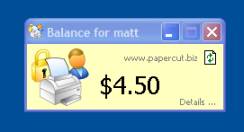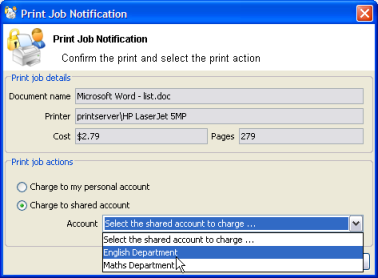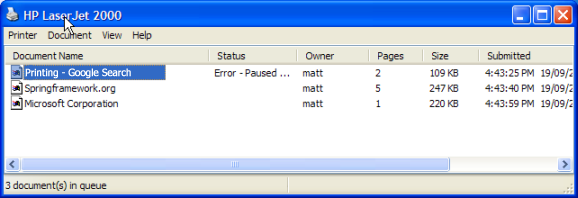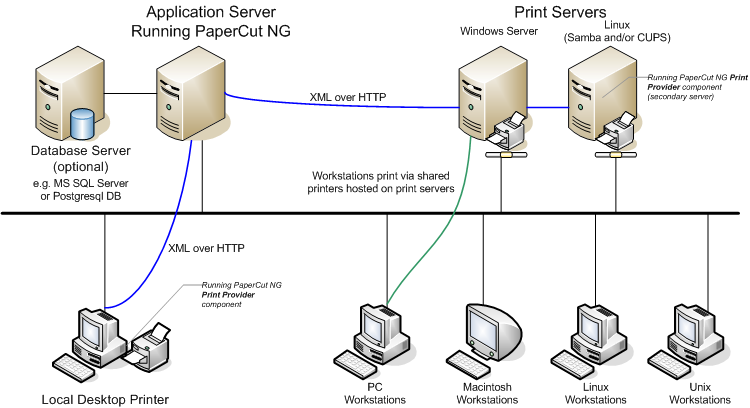Before explaining how PaperCut NG works at a technical and end-user level, the reader should be familiar with the following key concepts.
A print server is a system responsible for hosting print queues and sharing printer resources to desktop clients/workstations. Users on the workstations submit print jobs to a print server rather then directly to the printer itself. A print server may be a dedicated server but on most networks this server may also perform other tasks such as file serving.
In a multi-user environment, users log on to a network or computer using a username and password. These are often managed by services such as Active Directory or LDAP. The username is known as the user's identity. PaperCut NG uses this identity to track printing.
Client software is a small program that runs on each workstation and communicates with a server. The printing process on most networks works on a client/server model with clients (workstations) submitting jobs to a server. PaperCut NG also uses optional client software to help provide information to end-users. This also runs in a client/server model.
An application server is a server program responsible for centrally processing “business logic” and providing services to end-users. PaperCut NG uses the application server model to provide a “business logic” unit for calculating user costs and providing a web browser interface to end-users.
A provider is a software component or program responsible for providing information to an Application Server. PaperCut NG uses providers to submit print queue/job information to its application server. This information provider is called the Print Provider. Other importation providers included with PaperCut NG include user directory and authentication providers.
A web application is a software program that interacts with end-users via a web browser. Examples range from Google, Microsoft SharePoint, Hotmail, Internet banking and router management consoles. PaperCut NG provides a web-based interface for system administration and management. Web applications offer administration flexibility by allowing access from any location on the network and avoid the need for installation of separate software.
To help explain what PaperCut NG is and how it works we'll introduce the system by example.
The student's perspective:
Matt is a student at a local high school. He has logged onto the network using his username,
matt.j.smith, and is surfing the Internet. He would like to print out a web page for his school assignment.The network administrator has allocated Matt a printing credit budget of $10.00 a month. He can see his current account balance of $4.50 in the PaperCut Client Tool window.
Matt prints the web page. 5 pages come out of the printer.
The network administrator has set a cost-per-page inside PaperCut on the printer at $0.10. Matt's 5 page document costs $0.50.
Matt's account balance is now at $4.00. He may continue to print until his account drops to zero.
The teacher's perspective:
John is a science and mathematics teacher at the same local high school.
John needs to print out a presentation consisting of 122 page science worksheet for his next class.
The network administrator has granted John access to charge to either his personal account or to either the Science Department or Math Department's shared accounts.
John presses the button in the application.
The PaperCut client tool displays a popup and presents John with information about the print jobs and requests an account selection.
John selects the science department's shared account from the list.
The print job is charged to the science department's account.
The technical perspective:
When the teacher, John, prints his 150 page print jobs, his workstation transfers the print job to the server and places it in the print queue.
The PaperCut Print Provider intercepts the print job in the queue prior to printing and analyzes the information determining:
Who printed the document
The number of pages in the document
Other information such as duplex, grayscale mode, paper size, etc.
The Print Provider submits the job's information to the Application Server to process the “business logic”.
The Application Server determines that John needs to select the account to charge. It notifies the Client Software on John's desktop.
The Client Software displays the Popup requesting the account.
After John selects the client account, the Application Server is notified of John selection.
The Application Server charges the appropriate account, logs the job and instructs the Print Provider to transfer the document onto the printer.
PaperCut NG was developed using the latest software development strategies, a strong influence being Service Oriented Architecture (SOA). The Print Provider, Application Server and Client Software all communication uses XML based web services over HTTP.
A more detailed explanation of the architecture and how it relates to a multi-server installation can be found in subsequent sections.



